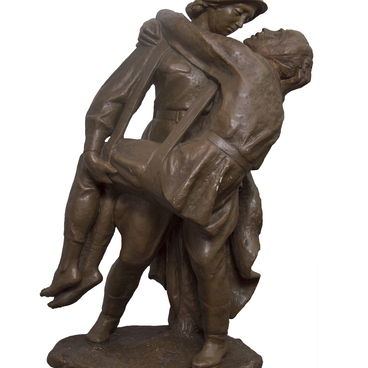The Military Medical Academy houses a copy of the book written by the French surgeon Ambroise Paré ‘Methods of Curing Firearm Wounds and Fractures’, which used to belong to the renowned doctor Nikolay Pirogov. In his work, Paré proposed a breakthrough method of treating gunshot wounds.
Ambroise Paré was born into a poor peasant family near the city of Laval, France, in 1510. His parents wanted him to get a profession, so they sent him to study with a barber. By the time he was 17 years old, Paré became seriously interested in surgery and left for Paris. There he entered a medical school, attended lectures at the recently opened College de France, and from 1533 to 1536 worked at the Hotel Dieu, the largest hospital in the city. In 1537, Paré received the title of surgeon and then joined the army in the field — to treat soldiers and gain new experience.
Many doctors of the 16th century considered the combustion products of gunpowder toxic, and gunshot wounds were considered poisonous. Treatment was particularly extreme and included cauterizing the wound with a red-hot iron or pouring boiling oil on the wound. During these procedures, the injured received additional burns and suffered from pain.
In 1539, after one of the battles, Ambroise Paré, who was a field surgeon at that time, ran out of boiling oil. Paré then treated the wounded by applying bandages with a special mixture, which consisted of turpentine, egg yolk and rose oil. The next morning, to his surprise, he found out that these patients were doing significantly better than those who had been cauterized. Their wounds looked better and their pain eased.
In 1545, Paré described those cases in detail in his work ‘Methods of Curing Firearm Wounds…’ and proposed to consider such wounds not poisoned, but bruised. Paré was also the first to prove that it was necessary to amputate limbs within the limits of healthy tissues and that ligatures — medical threads — had to be applied to large blood vessels. For ligation of vessels without cauterization, he used a linen thread and a curved triangular suture needle, which he had invented himself.
Furthermore, Ambroise Paré worked on extremity prostheses, corsets, orthopedic shoes. He became the first doctor who described a hip fracture and specified indications and contraindications for craniotomy, and improved a trephine saw, an instrument with a drill, which is used by surgeons to make holes in a bone or other dense tissue.
Since 1552, the experienced Paré served as a surgeon-in-ordinary, first at the court of Henry II, and then for kings Francis II, Charles IX, Henry III. By 1563, he had become the chief surgeon at the Hôtel-Dieu hospital and received the title of ‘the king’s first surgeon and obstetrician’. Ambroise Paré died on December 20, 1590, in Paris.
Ambroise Paré was born into a poor peasant family near the city of Laval, France, in 1510. His parents wanted him to get a profession, so they sent him to study with a barber. By the time he was 17 years old, Paré became seriously interested in surgery and left for Paris. There he entered a medical school, attended lectures at the recently opened College de France, and from 1533 to 1536 worked at the Hotel Dieu, the largest hospital in the city. In 1537, Paré received the title of surgeon and then joined the army in the field — to treat soldiers and gain new experience.
Many doctors of the 16th century considered the combustion products of gunpowder toxic, and gunshot wounds were considered poisonous. Treatment was particularly extreme and included cauterizing the wound with a red-hot iron or pouring boiling oil on the wound. During these procedures, the injured received additional burns and suffered from pain.
In 1539, after one of the battles, Ambroise Paré, who was a field surgeon at that time, ran out of boiling oil. Paré then treated the wounded by applying bandages with a special mixture, which consisted of turpentine, egg yolk and rose oil. The next morning, to his surprise, he found out that these patients were doing significantly better than those who had been cauterized. Their wounds looked better and their pain eased.
In 1545, Paré described those cases in detail in his work ‘Methods of Curing Firearm Wounds…’ and proposed to consider such wounds not poisoned, but bruised. Paré was also the first to prove that it was necessary to amputate limbs within the limits of healthy tissues and that ligatures — medical threads — had to be applied to large blood vessels. For ligation of vessels without cauterization, he used a linen thread and a curved triangular suture needle, which he had invented himself.
Furthermore, Ambroise Paré worked on extremity prostheses, corsets, orthopedic shoes. He became the first doctor who described a hip fracture and specified indications and contraindications for craniotomy, and improved a trephine saw, an instrument with a drill, which is used by surgeons to make holes in a bone or other dense tissue.
Since 1552, the experienced Paré served as a surgeon-in-ordinary, first at the court of Henry II, and then for kings Francis II, Charles IX, Henry III. By 1563, he had become the chief surgeon at the Hôtel-Dieu hospital and received the title of ‘the king’s first surgeon and obstetrician’. Ambroise Paré died on December 20, 1590, in Paris.



